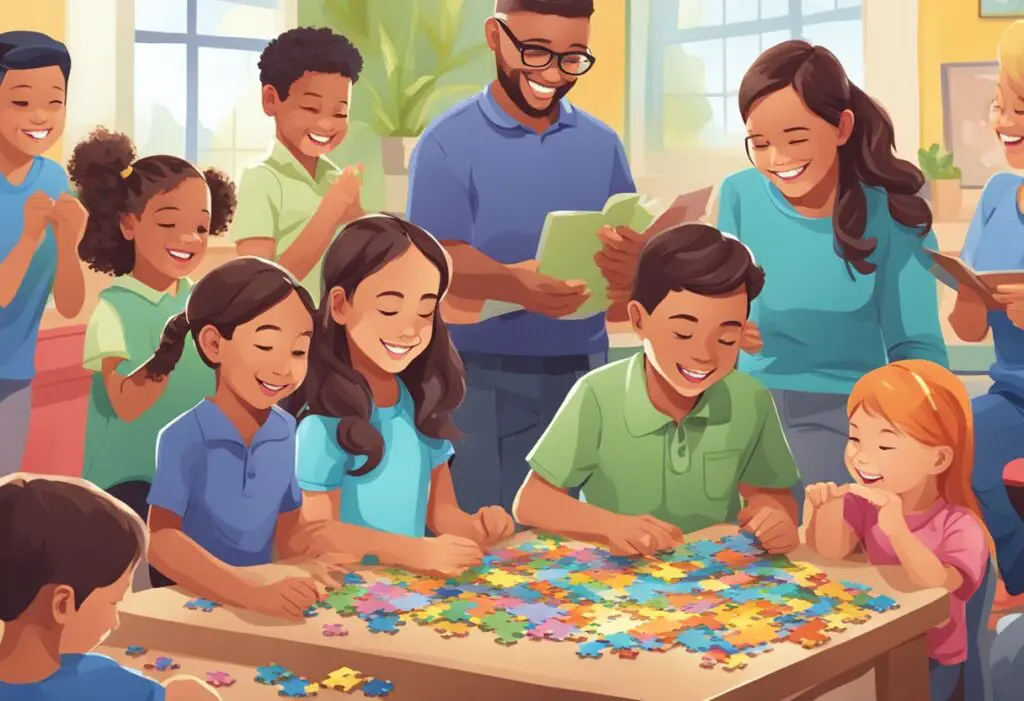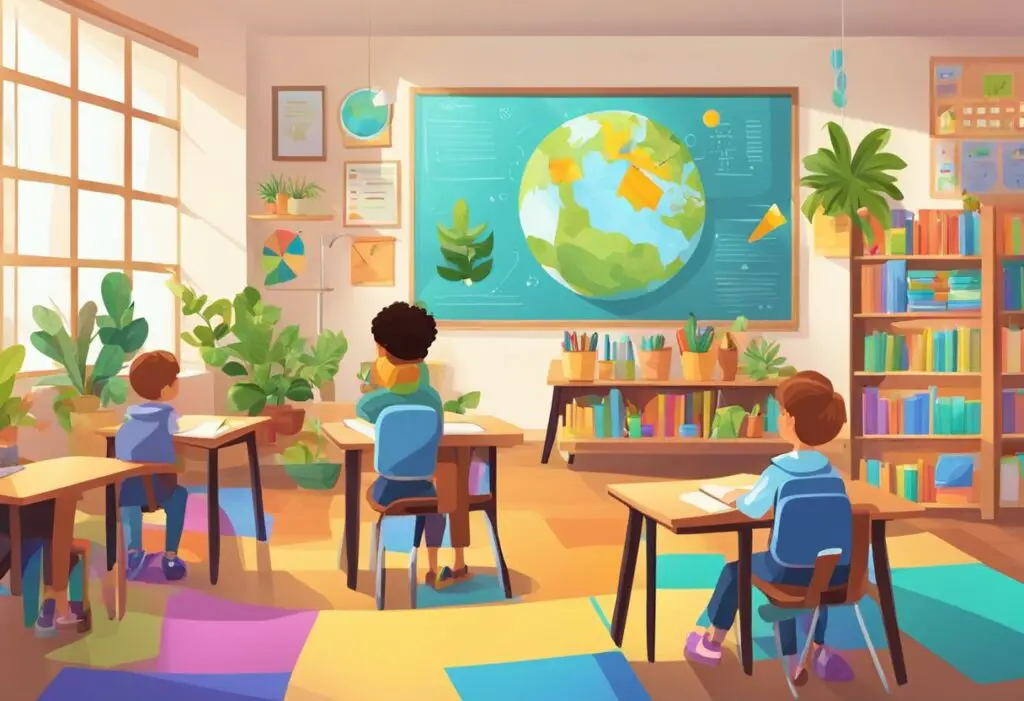Ever been tempted to pull your hair out when your kiddo slumps over their homework with a defeated “I can’t”? Well, strap in because you’re about to become the pep talk champion.
It’s all about switching gears from a mindset that’s about as effective as a chocolate teapot, to one that’s as sharp as a tack. We all know that tackling new challenges can sometimes feel like trying to solve a Rubik’s Cube in the dark. But fear not, by arming your children with the right tools, they’ll be turning those “I can’t” sighs into “I’m learning” high-fives in no time.

Let’s face it, the path to mastering anything is littered with more bumps and hiccups than a frog in a blender (not literally, of course). It’s no secret that the most legendary of figures didn’t just wake up awesome. Nope, they had to stumble a few times before they could moonwalk smoothly. So when your little champs face obstacles that seem as tall as a giant’s knee-high socks, it’s your mission to be the wind beneath their wings—or at least the gentle nudge that keeps them from spiraling into a pit of “I can’t” despair.
Imagine transforming your home into a dojo of determination, where “I can’t” turns into a battle cry for growth. Yes, you’ll need patience thicker than grandma’s famous triple-layer chocolate cake, and yes, the journey might zigzag like a rabbit on a skateboard. But march on! A sprinkle of humor, a spoonful of encouragement, and a dash of practical strategy is the secret sauce to fostering resilience in kids. Buckle up because we’re about to dive into some real, concrete steps that’ll have your youngsters tackling life’s curveballs like mini pros.
Unpacking the ‘I Can’t’ Mindset
Before you turn your kiddo’s “I CAN’T” into their “I’m totally nailing this learning thing,” let’s sneak a peek at what’s going on under the hood of that defeatist engine.
Identifying the Triggers
So, you’ve heard the dreaded “I can’t” from your offspring—for the umpteenth time, no less. Your mission, should you choose to accept it, is to put on your detective hat and identify the usual suspects causing this meltdown. Could be a tricky math problem or the violin strings that just won’t cooperate. Make a list, check it twice, and you’re on your way to becoming a triggers-whisperer.
Understanding the Psychology
It turns out, your little one’s “I can’t” is more than just a refusal to try; it’s like a tiny brain bouncer telling new skills they’re not on the list. Dive into the psychological mixtape at play here, featuring classic hits like ‘Fear of Failure’ and ‘Frustration Funk’. Understanding their mindset is like having the cheat codes to their internal video game—suddenly you’re helping them level up instead of rage quitting their way to “I can do this!”
-

Bold Male Pride – Baseball Trucker Cap Celebrating Masculinity
£18.00 Select options This product has multiple variants. The options may be chosen on the product page -

Dad Bod Appreciation Gift Mug
£14.00 Add to cart -

Dad Bod, Bad Jokes Structured Baseball Cap
£22.00 Select options This product has multiple variants. The options may be chosen on the product page
Remember, your goal isn’t to swat away the ‘I can’t’ like a pesky fly. It’s about acknowledging the struggle, equipping your child with a strategy playlist, and watching them transform into a problem-solving ninja—one ‘I’m learning’ at a time.
Cultivating a Growth Mindset

Transforming “I can’t” into “I’m learning” is like upgrading your mental software from “Panic Mode” to “Challenge Accepted.” Let’s boot up some strategies to keep your kiddos questing through difficulties with a smile.
The Power of Yet
Think of “yet” as the ultimate level-up potion. When your child says, “I can’t do this puzzle,” remix it to, “You haven’t nailed this puzzle…yet.” It’s not about waving a magic wand for instant genius—it’s about showing that skills are a work in progress.
- The “YET” board:
- Create a board where “can’t” phrases get a makeover with a sticky note tagged “yet.”
- Every “can’t” is a comedically exaggerated without the “yet,” like, “I can’t possibly fathom the complexities of this infernal contraption!” becomes, “I don’t get this contraption…yet.”
Celebrating Small Wins
You wouldn’t run a marathon and only cheer at the finish line, right? Little victories are like power-ups; they keep motivation high and the game exciting. Catch your child rocking a sub-skill and throw a mini-party.
- Victory Dance:
- Every time your child masters a small skill, do a victory dance.
- Whether it’s the “I tied my shoes” shuffle or the “I read a whole page” boogie, make it fun!
Games and laughter can make the grind of learning feel like an epic quest. So suit up, Player One, because those challenges don’t stand a chance against your family’s growth mindset toolkit.
Strategies for Overcoming Challenges
Turning “I can’t” into “I’m learning” isn’t just a snappy phrase to embroider on a pillow; it’s about equipping kids with a toolset that transforms stumbling blocks into stepping stones. So let’s jump right into the practical strategies that will have your kids saying “challenge accepted” with the enthusiasm of a gamer on a quest.
Problem-Solving Techniques
First off, you’ve got to understand that problem-solving is like a secret weapon, only it’s not so secret and definitely not as dramatic as it sounds. Start by breaking down the big scary problem into bite-sized pieces. You might find that the issue isn’t as big and bad as it seemed. It’s like when your internet crashes, and you feel like you’ve been plunged back into the dark ages. Instead of panicking, you troubleshoot: check the router, disconnect, reconnect, or even—brace yourself—call tech support. Encourage your kids to list out the steps to tackle their problems, and remind them that sometimes, the solution is as simple as “have you tried turning it off and on again?”
- Identify the challenge: What’s making your child say “I can’t”?
- Break it down: What are the individual steps needed to solve the problem?
- Seek solutions: Encourage them to brainstorm and write down possible solutions.
- Try and try again: Like in a tough level of a video game, if one strategy fails, it’s time to try another path.
Encouraging Curiosity and Experimentation
Curiosity didn’t kill the cat—boredom did. Remind your kiddos that experimenting and making mistakes is how humans got to the moon, invented sliced bread, and why there are approximately a billion types of iPhone cases. Encourage your kids to view challenges as a sandbox game: dig around, build something, knock it down, and start over with no real consequences except the thrill of discovery!
- Ask questions: “What might happen if we do this?”
- Tinker: Just like messing with game settings to optimize performance, encourage tweaking things in real life.
- Learn from others: Watch videos, find experts, and gain new skills that make them want to dive back into the fray.
Remember, turning “I can’t” into “I’m learning” is all about empowering your kids with the confidence to face obstacles head-on and with a grin. Keep it light, keep it fun, and watch them level up in the game of life.
Integrating Fun into Learning
Who says education has to be as dull as watching paint dry? Amp up your kiddo’s grit with a dash of playtime pizzazz!
Educational Games
You know your little Einstein can’t resist the allure of games—even the broccoli of board games, Monopoly, has its charms! Why not sneak in some stealthy learning with educational games that disguise the “eww” of effort with the “ahh” of amusement? Games that blend math puzzles, word play, and even history trivia can transform a “Yuck, I can’t” into an “Oops, I’m winning–and learning!”
Example:
- Math Land: Navigate pirate islands with addition and subtraction as your trusty compass.
- Scrabble: Who knew building a high-scoring word could boost your vocabulary quicker than a dictionary on a merry-go-round?
Interactive Learning Platforms
Wave goodbye to bored, disinterested faces with interactive learning platforms that make the internet less about cat videos (although, no judgement if that’s your jam) and more about participative, hands-on education. These platforms invite your child to build, experiment, and yes, even fail—all without the soul-crushing fear of mistakes.
- Sites to Explore:
- Duolingo: Learning French while accruing points like a gamer? Oui, s’il vous plaît!
- Khan Academy: Turn the dread of algebra into a quest for cosmic rewards.
Encourage your child to dive into these digital wonderlands where, amidst the fun and games, learning is the sneakiest guest at the party.
Technological Tools and Resources
Before you throw your hands up in the air and surrender to the “I can’ts” your kids chant like a broken record, let’s weaponize you with some cutting-edge tech savvy. It’s time to turn the tables and use the behemoth that is the internet to your advantage.
Online Communities
Ever thought the internet was just for cat videos and memes? Think again! It’s a goldmine for communities where your kids can post a math problem tougher than a two-dollar steak and get solutions that are easier to digest than said steak. For example, MIT’s OpenCourseWare offers a platform where the brainy folks have put together resources that can tutor your kiddos into whiz-kids.
Learning Apps and Websites
Roll out the virtual red carpet for apps and websites that can transform your reluctant learner into an eager beaver. Boldly download apps that gamify learning because, let’s face it, who wouldn’t rather earn points and level up than do boring old worksheets? Websites like Khan Academy not only offer free tutorials on just about anything, but they also know how to keep your young ones glued to subjects with as much charm as a penguin in a tuxedo.
So there you have it, your secret arsenal in the battle against the dreaded “I can’t” – use them wisely!







